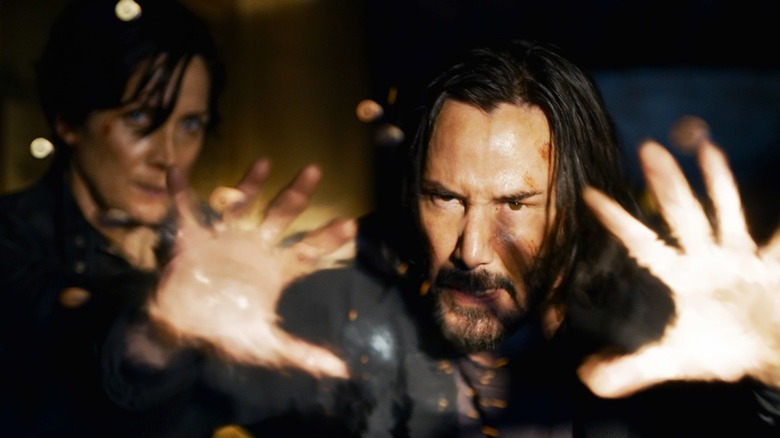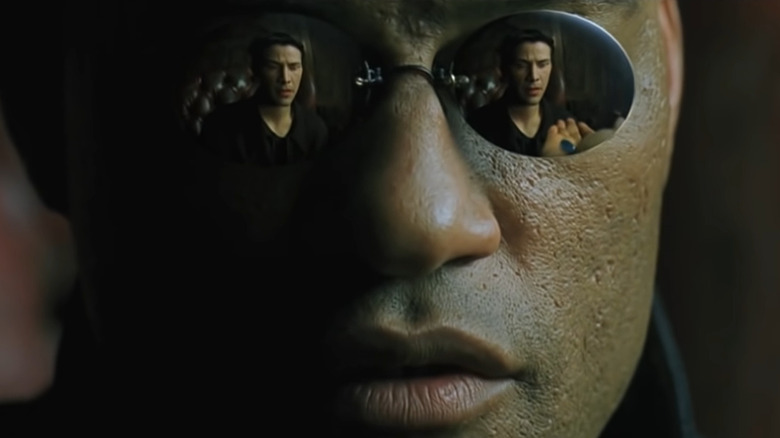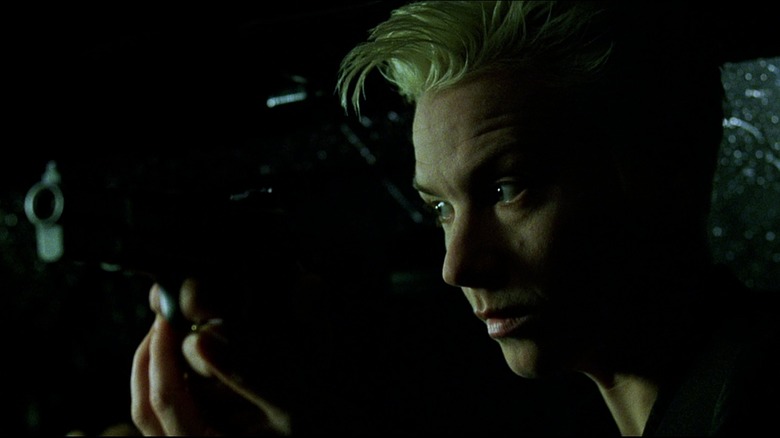The Meaning Of The Matrix Was Much More Direct In Early Drafts
It's been abundantly clear over the past few decades that it usually doesn't matter what the writers' intentions were — people will still badly misinterpret a movie or show regardless of how unsubtle it is. It's why after three seasons of "The Boys," you still have some extremely right-wing viewers who don't understand that Homelander (Antony Starr) is supposed to be the villain. It's why a loud section of "Breaking Bad" fans loved Walt (Bryan Cranston) and hated his wife, even after five seasons of Walt's evil became more and more blatant. Perhaps the big example is how "The Matrix," a movie created by two transwomen with obvious left-wing political views throughout all their works, had its concept of the red pill adopted by the alt-right.
To be fair, "The Matrix" isn't technically about one single thing. This is made clear in "The Matrix Resurrections," which features a meta montage in which a bunch of writers try to pinpoint the real meaning of the in-universe Matrix video games. Among the assertions we get from the characters in the scene: the Matrix is about "trans politics," "crypto fascism," and "capitalist exploitation." The framing of the scene implies that none of these are completely right. Or rather, that they're valid interpretations, but the "Matrix" movies cannot be summed up so easily. Trying to reduce them to any one-to-one parallel would do the series a disservice.
That said, if you want to look at the movie through a trans lens, you're going to find a lot to work with. This has not gone unnoticed by trans critics and writers, and it is backed up by some of the earlier versions of "The Matrix" itself.
The Matrix as a trans allegory
As culture critic Emily St. James once put it: "If you are a trans person, there is sort of this idea that you are living in a muffling cocoon that is keeping you from seeing the reality of yourself, and that cocoon, to some degree, is the idea of fixed gender identity, which is one that society is very built atop." It's easy to see how a trans person watching the first third of "The Matrix" would see their pre-transition self in Neo, a man who is unhappy with his seemingly normal, comfortable life but knows on some indefinable level that something is deeply wrong.
"And to be trans," St. James explained further, "You have to sort of assail that idea, and in the process of doing so, you may question other things about reality, including whether you live in a computer simulation, which is robots using humans as a way to power their existence." The rest of the first film revolves around Neo realizing his original life was a lie. He then struggles and eventually succeeds in finding his new identity outside the Matrix, finding a path for himself much more suitable for him than the path ordained on him inside the Matrix.
Perhaps the most blatant parallel to the trans experience is the movie's incorporation of deadnaming. Neo changes his name when he leaves the Matrix, and the villain Agent Smith (Hugo Weaving) keeps referring to him by his old name as a way of taunting him. This culminates in a scene where Agent Smith calls him Mr. Anderson as he's choking Neo to death. Neo defiantly says, "My name is Neo," before breaking free and forcing Smith into the path of a train. (A worthy fate for any deadnamer!)
The original draft was even more trans
In interviews after they came out as trans, the Wachowskis essentially confirmed the connections people have made. "The Matrix stuff was all about the desire for transformation but it was all coming from a closeted point of view," Lilly Wachowski stated.
The original draft for the movie also featured the character Switch (Belinda McClory) as someone who presented as female when she was in the Matrix and as male outside of it, but the studio apparently forced them to stick to a single actress — and a single gender — when filming. "There was an early draft of the script where the Matrix avatar would be a different sex than the Zion reality," Keanu Reeves recalled. "I think the studio wasn't ready for that version."
In the finished film, Switch still stands out through her pitch-white clothing and her white-blonde hair. In a movie where everyone's dressed in pitch black, she's consistently dressed in white. Although the gender-swapping aspect of her character was removed, the movie still went out of its way to make her as memorable as possible, despite her limited role in the overall story.
As the Wachowskis have gotten more creative freedom over the years and as trans stories have become more common in mainstream media, they've been allowed to create more explicitly queer film and television over the years. "Sense8," for instance, is a masterpiece of a show that also heavily centers a trans character who's in a happy, fulfilling relationship with another woman. And unlike Switch, that character gets to a have a happy ending. The original "Matrix" may not have been allowed to be openly queer like the Wachowskis' later works, but it's easy to see in it the signs of what was to come.


